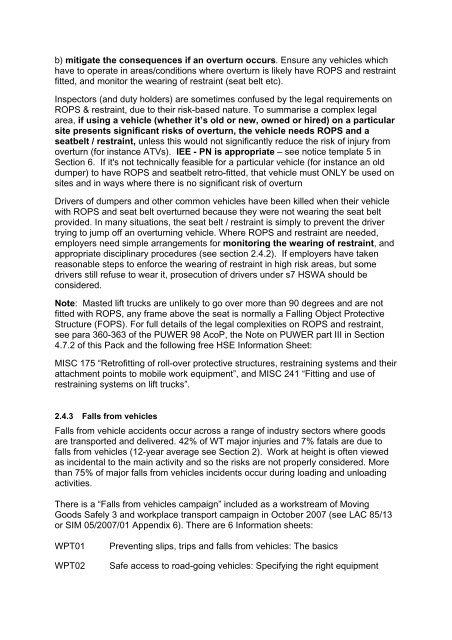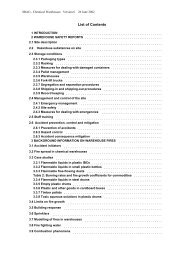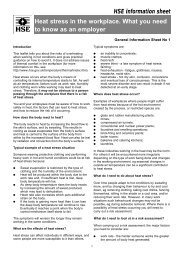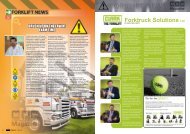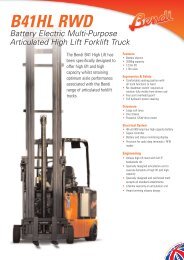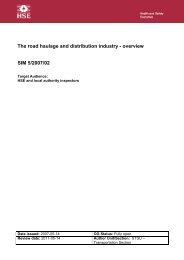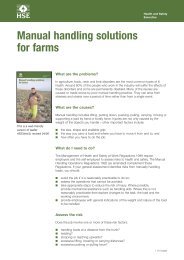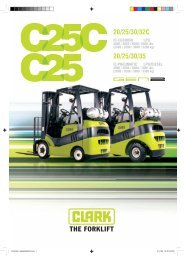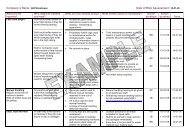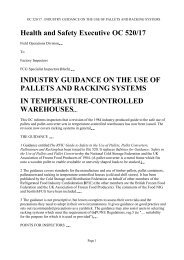Workplace transport inspection pack
Workplace transport inspection pack
Workplace transport inspection pack
You also want an ePaper? Increase the reach of your titles
YUMPU automatically turns print PDFs into web optimized ePapers that Google loves.
) mitigate the consequences if an overturn occurs. Ensure any vehicles whichhave to operate in areas/conditions where overturn is likely have ROPS and restraintfitted, and monitor the wearing of restraint (seat belt etc).Inspectors (and duty holders) are sometimes confused by the legal requirements onROPS & restraint, due to their risk-based nature. To summarise a complex legalarea, if using a vehicle (whether it’s old or new, owned or hired) on a particularsite presents significant risks of overturn, the vehicle needs ROPS and aseatbelt / restraint, unless this would not significantly reduce the risk of injury fromoverturn (for instance ATVs). IEE - PN is appropriate – see notice template 5 inSection 6. If it's not technically feasible for a particular vehicle (for instance an olddumper) to have ROPS and seatbelt retro-fitted, that vehicle must ONLY be used onsites and in ways where there is no significant risk of overturnDrivers of dumpers and other common vehicles have been killed when their vehiclewith ROPS and seat belt overturned because they were not wearing the seat beltprovided. In many situations, the seat belt / restraint is simply to prevent the drivertrying to jump off an overturning vehicle. Where ROPS and restraint are needed,employers need simple arrangements for monitoring the wearing of restraint, andappropriate disciplinary procedures (see section 2.4.2). If employers have takenreasonable steps to enforce the wearing of restraint in high risk areas, but somedrivers still refuse to wear it, prosecution of drivers under s7 HSWA should beconsidered.Note: Masted lift trucks are unlikely to go over more than 90 degrees and are notfitted with ROPS, any frame above the seat is normally a Falling Object ProtectiveStructure (FOPS). For full details of the legal complexities on ROPS and restraint,see para 360-363 of the PUWER 98 AcoP, the Note on PUWER part III in Section4.7.2 of this Pack and the following free HSE Information Sheet:MISC 175 “Retrofitting of roll-over protective structures, restraining systems and theirattachment points to mobile work equipment”, and MISC 241 “Fitting and use ofrestraining systems on lift trucks”.2.4.3 Falls from vehiclesFalls from vehicle accidents occur across a range of industry sectors where goodsare <strong>transport</strong>ed and delivered. 42% of WT major injuries and 7% fatals are due tofalls from vehicles (12-year average see Section 2). Work at height is often viewedas incidental to the main activity and so the risks are not properly considered. Morethan 75% of major falls from vehicles incidents occur during loading and unloadingactivities.There is a “Falls from vehicles campaign” included as a workstream of MovingGoods Safely 3 and workplace <strong>transport</strong> campaign in October 2007 (see LAC 85/13or SIM 05/2007/01 Appendix 6). There are 6 Information sheets:WPT01WPT02Preventing slips, trips and falls from vehicles: The basicsSafe access to road-going vehicles: Specifying the right equipment


